2004 FORD F350 width
[x] Cancel search: widthPage 165 of 312
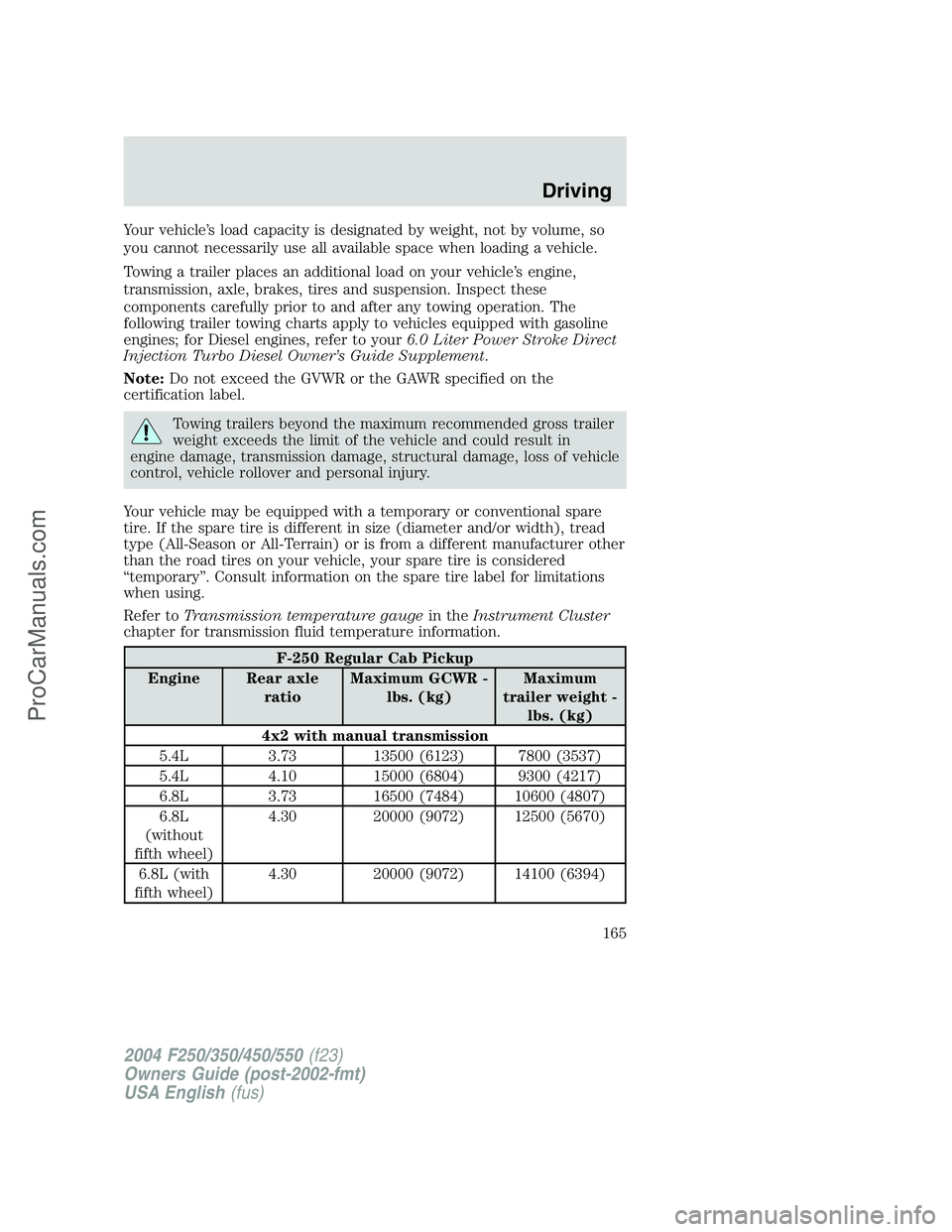
Your vehicle’s load capacity is designated by weight, not by volume, so
you cannot necessarily use all available space when loading a vehicle.
Towing a trailer places an additional load on your vehicle’s engine,
transmission, axle, brakes, tires and suspension. Inspect these
components carefully prior to and after any towing operation. The
following trailer towing charts apply to vehicles equipped with gasoline
engines; for Diesel engines, refer to your6.0 Liter Power Stroke Direct
Injection Turbo Diesel Owner’s Guide Supplement.
Note:Do not exceed the GVWR or the GAWR specified on the
certification label.
Towing trailers beyond the maximum recommended gross trailer
weight exceeds the limit of the vehicle and could result in
engine damage, transmission damage, structural damage, loss of vehicle
control, vehicle rollover and personal injury.
Your vehicle may be equipped with a temporary or conventional spare
tire. If the spare tire is different in size (diameter and/or width), tread
type (All-Season or All-Terrain) or is from a different manufacturer other
than the road tires on your vehicle, your spare tire is considered
“temporary”. Consult information on the spare tire label for limitations
when using.
Refer toTransmission temperature gaugein theInstrument Cluster
chapter for transmission fluid temperature information.
F-250 Regular Cab Pickup
Engine Rear axle
ratioMaximum GCWR -
lbs. (kg)Maximum
trailer weight -
lbs. (kg)
4x2 with manual transmission
5.4L 3.73 13500 (6123) 7800 (3537)
5.4L 4.10 15000 (6804) 9300 (4217)
6.8L 3.73 16500 (7484) 10600 (4807)
6.8L
(without
fifth wheel)4.30 20000 (9072) 12500 (5670)
6.8L (with
fifth wheel)4.30 20000 (9072) 14100 (6394)
2004 F250/350/450/550(f23)
Owners Guide (post-2002-fmt)
USA English(fus)
Driving
165
ProCarManuals.com
Page 187 of 312

•Your vehicle may be equipped with a temporary or conventional spare
tire. If the spare tire is different in size (diameter and/or width), tread
type (All-Season or All-Terrain) or is from a different manufacturer
other than the road tires on your vehicle, your spare tire is considered
“temporary”. Consult information on the spare tire label for limitations
when using.
Servicing after towing
If you tow a trailer for long distances, your vehicle will require more
frequent service intervals. Refer to yourScheduled Maintenance Guide
for more information.
Trailer towing tips
•Practice turning, stopping and backing up before starting on a trip to
get the feel of the vehicle trailer combination. When turning, make
wider turns so the trailer wheels will clear curbs and other obstacles.
•Allow more distance for stopping with a trailer attached.
•The trailer tongue weight should be 10–15% of the loaded trailer
weight.
•After you have traveled 50 miles (80 km), thoroughly check your
hitch, electrical connections and trailer wheel lug nuts.
•To aid in engine/transmission cooling and A/C efficiency during hot
weather while stopped in traffic, place the gearshift lever in P (Park)
(automatic transmission) or N (Neutral) (manual transmissions).
•Vehicles with trailers should not be parked on a grade. If you must
park on a grade, place wheel chocks under the trailer’s wheels.
Launching or retrieving a boat
When backing down a ramp during boat launching or retrieval,
•Do not allow the static water level to rise above the bottom edge of
the rear bumper.
•Do not allow waves to break higher than 6 inches (15 cm) above the
bottom edge of the rear bumper.
•Disconnect the trailer tow electrical connector to prevent blown fuses
caused by water entering into your trailer’s electrical wiring.
Exceeding these limits may allow water to enter critical vehicle
components, adversely affecting driveability, emissions and reliability.
Replace front and rear axle lubricants any time the axles have been
submerged in water. Axle lubricant quantities are not to be checked
unless a leak is suspected.
2004 F250/350/450/550(f23)
Owners Guide (post-2002-fmt)
USA English(fus)
Driving
187
ProCarManuals.com
Page 268 of 312
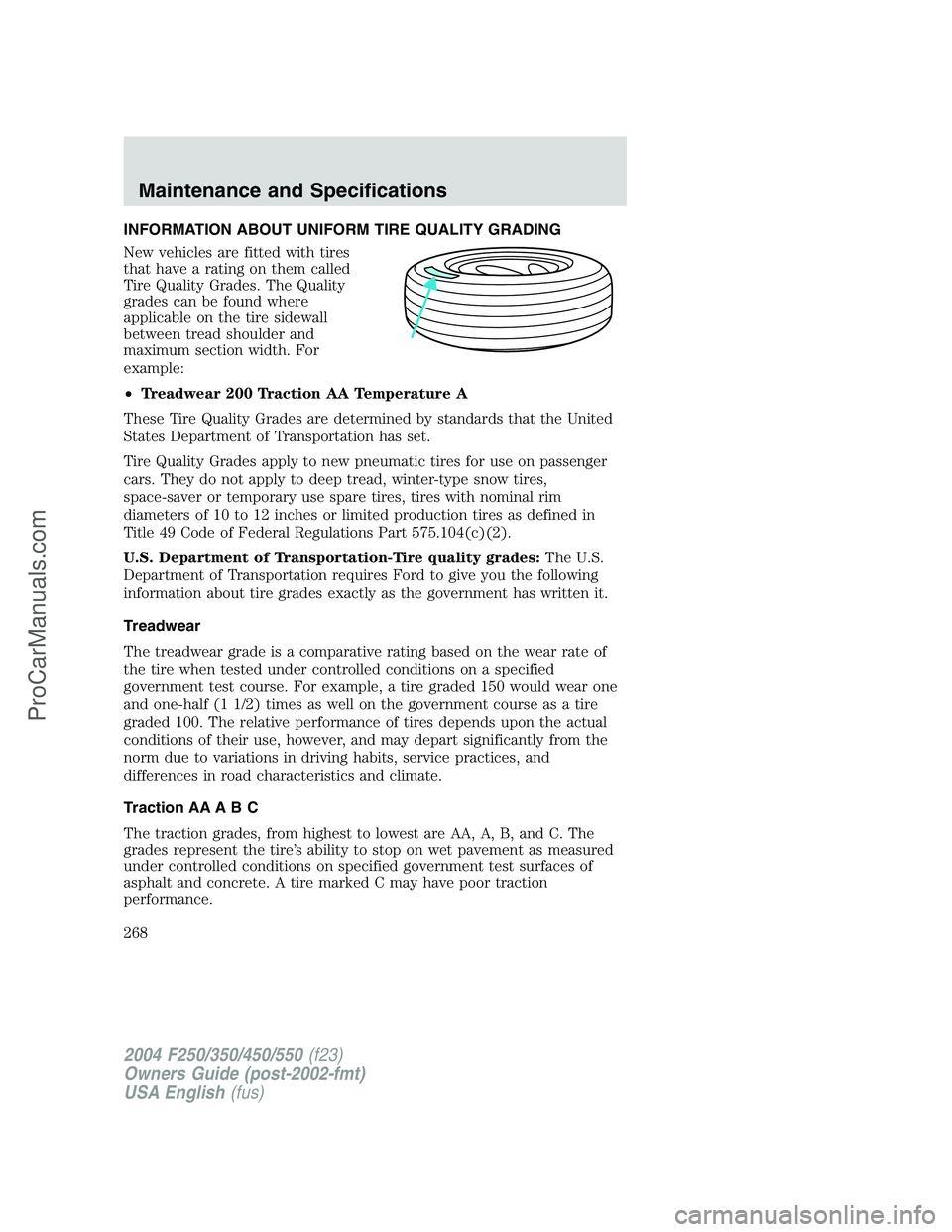
INFORMATION ABOUT UNIFORM TIRE QUALITY GRADING
New vehicles are fitted with tires
that have a rating on them called
Tire Quality Grades. The Quality
grades can be found where
applicable on the tire sidewall
between tread shoulder and
maximum section width. For
example:
•Treadwear 200 Traction AA Temperature A
These Tire Quality Grades are determined by standards that the United
States Department of Transportation has set.
Tire Quality Grades apply to new pneumatic tires for use on passenger
cars. They do not apply to deep tread, winter-type snow tires,
space-saver or temporary use spare tires, tires with nominal rim
diameters of 10 to 12 inches or limited production tires as defined in
Title 49 Code of Federal Regulations Part 575.104(c)(2).
U.S. Department of Transportation-Tire quality grades:The U.S.
Department of Transportation requires Ford to give you the following
information about tire grades exactly as the government has written it.
Treadwear
The treadwear grade is a comparative rating based on the wear rate of
the tire when tested under controlled conditions on a specified
government test course. For example, a tire graded 150 would wear one
and one-half (1 1/2) times as well on the government course as a tire
graded 100. The relative performance of tires depends upon the actual
conditions of their use, however, and may depart significantly from the
norm due to variations in driving habits, service practices, and
differences in road characteristics and climate.
Traction AA A B C
The traction grades, from highest to lowest are AA, A, B, and C. The
grades represent the tire’s ability to stop on wet pavement as measured
under controlled conditions on specified government test surfaces of
asphalt and concrete. A tire marked C may have poor traction
performance.
2004 F250/350/450/550(f23)
Owners Guide (post-2002-fmt)
USA English(fus)
Maintenance and Specifications
268
ProCarManuals.com
Page 271 of 312
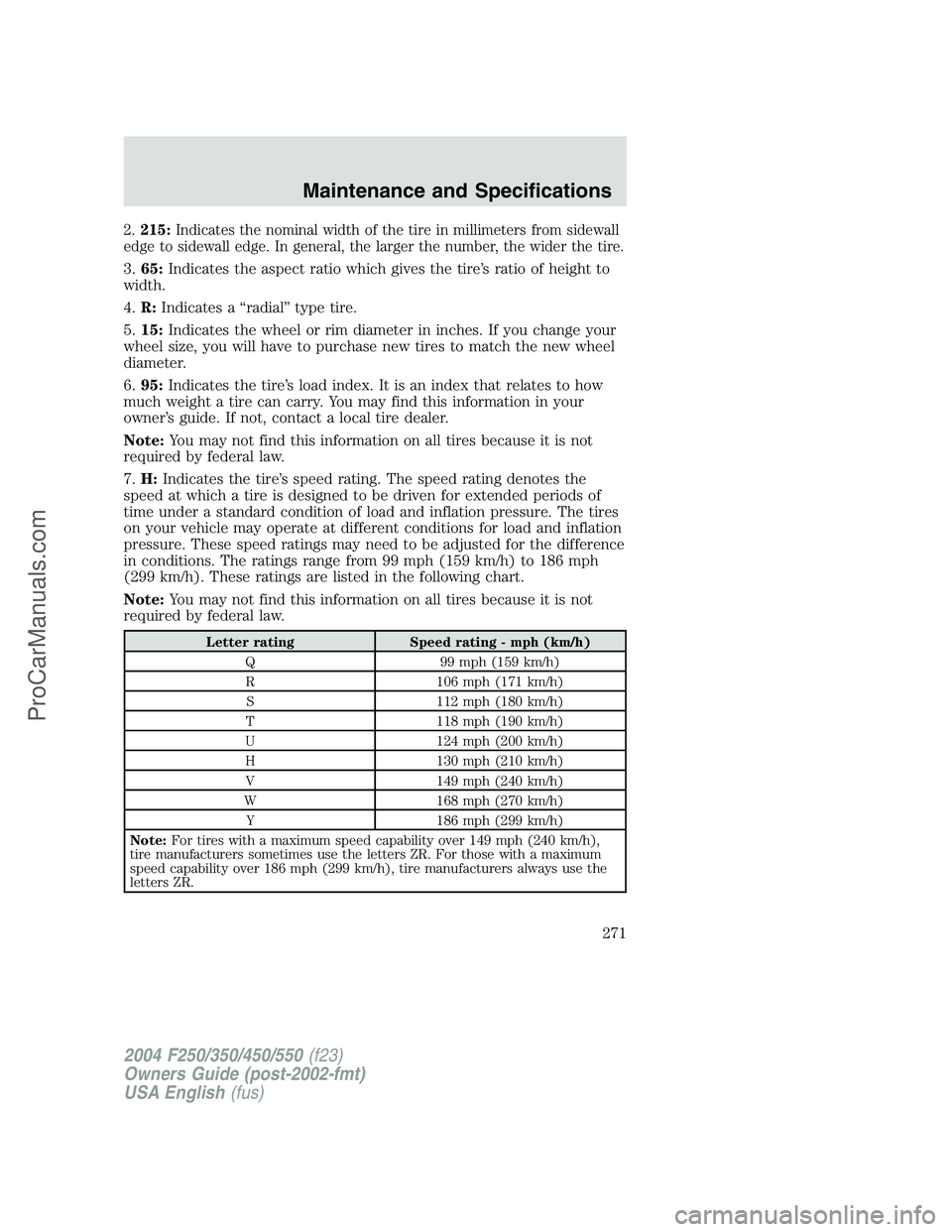
2.215:Indicates the nominal width of the tire in millimeters from sidewall
edge to sidewall edge. In general, the larger the number, the wider the tire.
3.65:Indicates the aspect ratio which gives the tire’s ratio of height to
width.
4.R:Indicates a“radial”type tire.
5.15:Indicates the wheel or rim diameter in inches. If you change your
wheel size, you will have to purchase new tires to match the new wheel
diameter.
6.95:Indicates the tire’s load index. It is an index that relates to how
much weight a tire can carry. You may find this information in your
owner’s guide. If not, contact a local tire dealer.
Note:You may not find this information on all tires because it is not
required by federal law.
7.H:Indicates the tire’s speed rating. The speed rating denotes the
speed at which a tire is designed to be driven for extended periods of
time under a standard condition of load and inflation pressure. The tires
on your vehicle may operate at different conditions for load and inflation
pressure. These speed ratings may need to be adjusted for the difference
in conditions. The ratings range from 99 mph (159 km/h) to 186 mph
(299 km/h). These ratings are listed in the following chart.
Note:You may not find this information on all tires because it is not
required by federal law.
Letter rating Speed rating - mph (km/h)
Q 99 mph (159 km/h)
R 106 mph (171 km/h)
S 112 mph (180 km/h)
T 118 mph (190 km/h)
U 124 mph (200 km/h)
H 130 mph (210 km/h)
V 149 mph (240 km/h)
W 168 mph (270 km/h)
Y 186 mph (299 km/h)
Note:For tires with a maximum speed capability over 149 mph (240 km/h),
tire manufacturers sometimes use the letters ZR. For those with a maximum
speed capability over 186 mph (299 km/h), tire manufacturers always use the
letters ZR.
2004 F250/350/450/550(f23)
Owners Guide (post-2002-fmt)
USA English(fus)
Maintenance and Specifications
271
ProCarManuals.com
Page 274 of 312
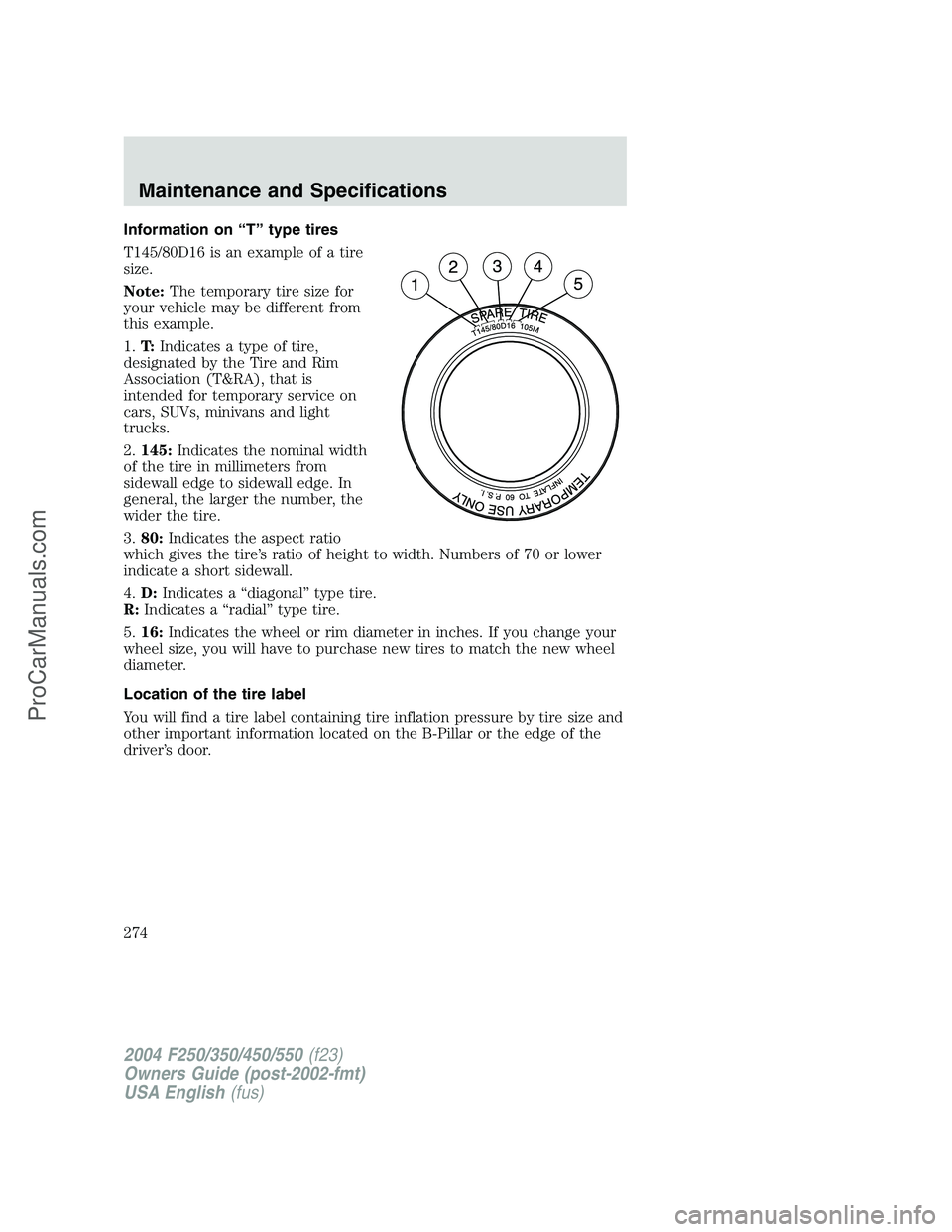
Information on“T”type tires
T145/80D16 is an example of a tire
size.
Note:The temporary tire size for
your vehicle may be different from
this example.
1.T:Indicates a type of tire,
designated by the Tire and Rim
Association (T&RA), that is
intended for temporary service on
cars, SUVs, minivans and light
trucks.
2.145:Indicates the nominal width
of the tire in millimeters from
sidewall edge to sidewall edge. In
general, the larger the number, the
wider the tire.
3.80:Indicates the aspect ratio
which gives the tire’s ratio of height to width. Numbers of 70 or lower
indicate a short sidewall.
4.D:Indicates a“diagonal”type tire.
R:Indicates a“radial”type tire.
5.16:Indicates the wheel or rim diameter in inches. If you change your
wheel size, you will have to purchase new tires to match the new wheel
diameter.
Location of the tire label
You will find a tire label containing tire inflation pressure by tire size and
other important information located on the B-Pillar or the edge of the
driver’s door.
2004 F250/350/450/550(f23)
Owners Guide (post-2002-fmt)
USA English(fus)
Maintenance and Specifications
274
ProCarManuals.com
Page 291 of 312

ENGINE DATA
Engine 5.4L V8 engine 6.8L V10 engine
Cubic inches 330 415
Required fuel 87 octane 87 octane
Firing order 1-3-7-2-6-5-4-8 1-6-5-10-2-7-3-8-4-9
Ignition system Coil on plug Coil on plug
Compression ratio 9.0:1 9.0:1
*Refer to the6.0 Liter Power Stroke Direct Injection Turbo Diesel
Owner’s Guide Supplementfor Motorcraft diesel engine service part
numbers.
VEHICLE DIMENSIONS
F–250 Regular Cab and SuperCab
Dimension Body style
Regular
Cab 4x2–
inches
(mm)Regular
Cab 4x4–
inches
(mm)SuperCab
4x2–
inches
(mm)SuperCab
4x4–
inches
(mm)
(1) Overall
height76.2 (1935) 78.9 (2005) 76.5 (1943)
b79.0 (2008)b
(2) Track -
Front/Rear68.3
(1736)/68.0
(1729)68.3 (1736) /
68.0 (1729)68.3 (1736) /
68.0 (1729)68.3 (1736) /
68.0 (1729)
(3) Overall
width79.9 (2031) 79.9 (2031) 79.9 (2031) 79.9 (2031)
(4)
Wheelbase137.0
(3479.8)137.0
(3479.8)141.8
(3610.7)
a
158.0
(4013.2)b
141.8
(3610.7)a
158.0
(4013.2)b
(5) Overall
length227.0
(5767)227.0 (5767) 231.9
(5889)a
248.0
(6300)b
231.9
(5889)a
248.0
(6300)b
a
Short Wheel Base (SWB)bLong Wheel Base (LWB)
2004 F250/350/450/550(f23)
Owners Guide (post-2002-fmt)
USA English(fus)
Maintenance and Specifications
291
ProCarManuals.com
Page 292 of 312
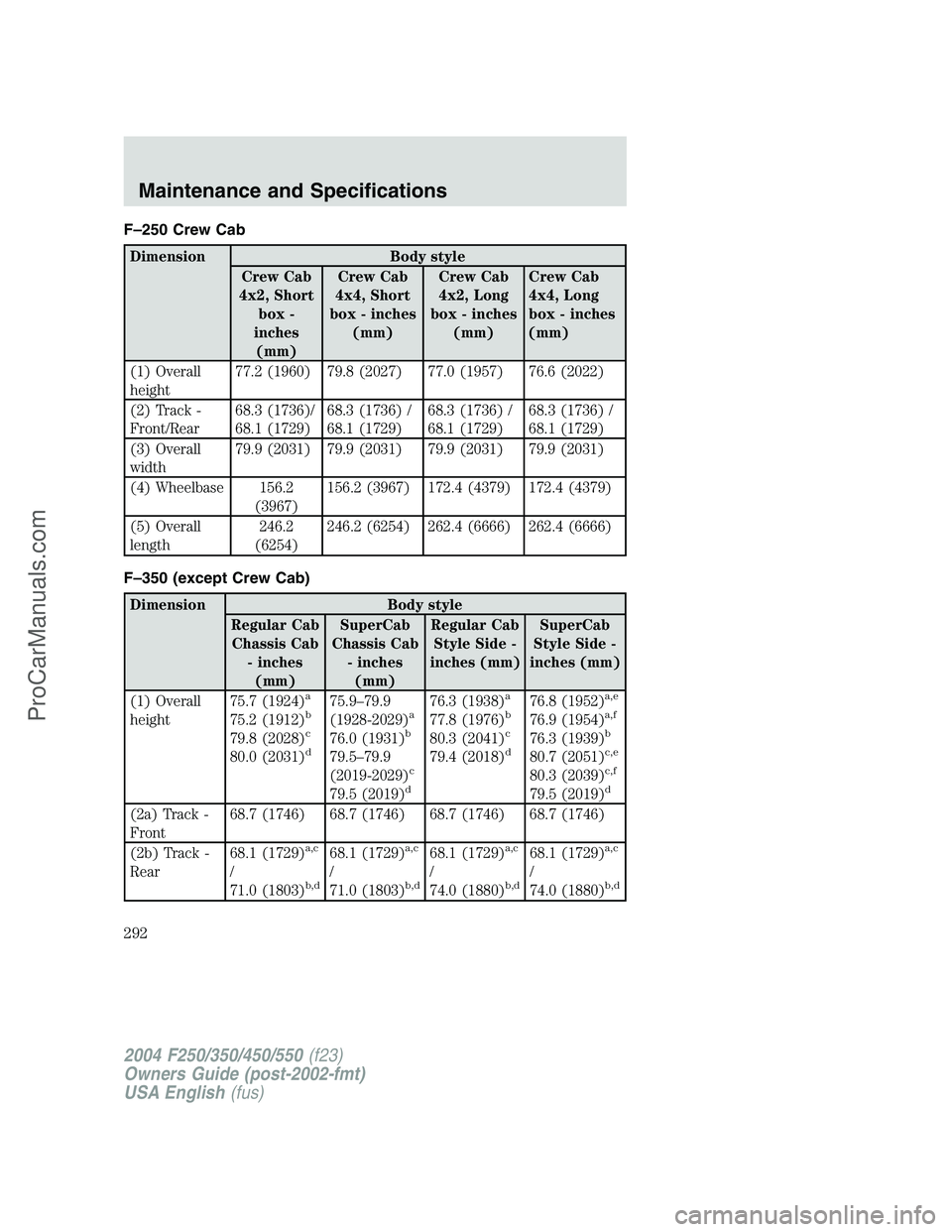
F–250 Crew Cab
Dimension Body style
Crew Cab
4x2, Short
box -
inches
(mm)Crew Cab
4x4, Short
box - inches
(mm)Crew Cab
4x2, Long
box - inches
(mm)Crew Cab
4x4, Long
box - inches
(mm)
(1) Overall
height77.2 (1960) 79.8 (2027) 77.0 (1957) 76.6 (2022)
(2) Track -
Front/Rear68.3 (1736)/
68.1 (1729)68.3 (1736) /
68.1 (1729)68.3 (1736) /
68.1 (1729)68.3 (1736) /
68.1 (1729)
(3) Overall
width79.9 (2031) 79.9 (2031) 79.9 (2031) 79.9 (2031)
(4) Wheelbase 156.2
(3967)156.2 (3967) 172.4 (4379) 172.4 (4379)
(5) Overall
length246.2
(6254)246.2 (6254) 262.4 (6666) 262.4 (6666)
F–350 (except Crew Cab)
Dimension Body style
Regular Cab
Chassis Cab
- inches
(mm)SuperCab
Chassis Cab
- inches
(mm)Regular Cab
Style Side -
inches (mm)SuperCab
Style Side -
inches (mm)
(1) Overall
height75.7 (1924)
a
75.2 (1912)b
79.8 (2028)c
80.0 (2031)d
75.9–79.9
(1928-2029)a
76.0 (1931)b
79.5–79.9
(2019-2029)c
79.5 (2019)d
76.3 (1938)a
77.8 (1976)b
80.3 (2041)c
79.4 (2018)d
76.8 (1952)a,e
76.9 (1954)a,f
76.3 (1939)b
80.7 (2051)c,e
80.3 (2039)c,f
79.5 (2019)d
(2a) Track -
Front68.7 (1746) 68.7 (1746) 68.7 (1746) 68.7 (1746)
(2b) Track -
Rear68.1 (1729)
a,c
/
71.0 (1803)b,d
68.1 (1729)a,c
/
71.0 (1803)b,d
68.1 (1729)a,c
/
74.0 (1880)b,d
68.1 (1729)a,c
/
74.0 (1880)b,d
2004 F250/350/450/550(f23)
Owners Guide (post-2002-fmt)
USA English(fus)
Maintenance and Specifications
292
ProCarManuals.com
Page 293 of 312
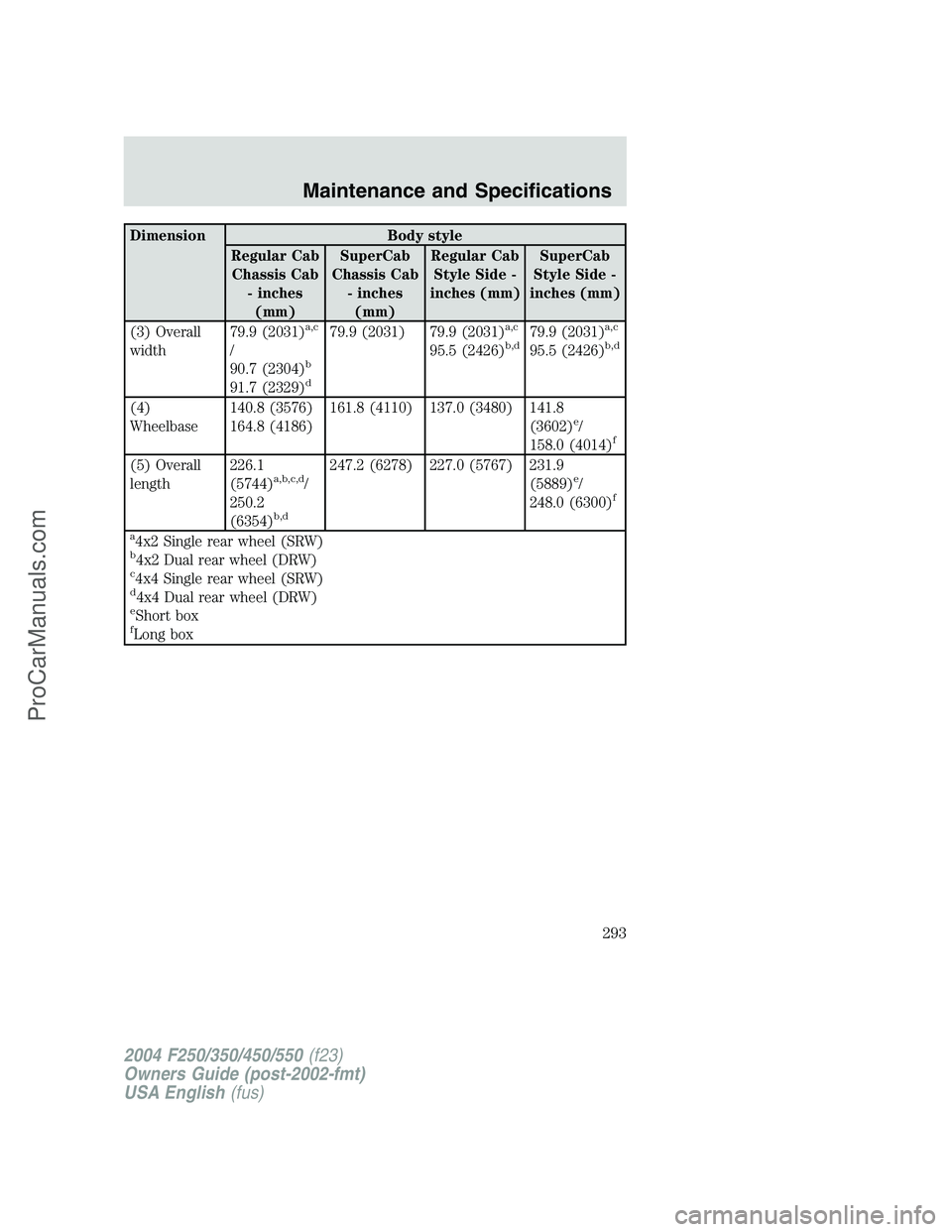
Dimension Body style
Regular Cab
Chassis Cab
- inches
(mm)SuperCab
Chassis Cab
- inches
(mm)Regular Cab
Style Side -
inches (mm)SuperCab
Style Side -
inches (mm)
(3) Overall
width79.9 (2031)
a,c
/
90.7 (2304)b
91.7 (2329)d
79.9 (2031) 79.9 (2031)a,c
95.5 (2426)b,d79.9 (2031)a,c
95.5 (2426)b,d
(4)
Wheelbase140.8 (3576)
164.8 (4186)161.8 (4110) 137.0 (3480) 141.8
(3602)e/
158.0 (4014)f
(5) Overall
length226.1
(5744)a,b,c,d/
250.2
(6354)
b,d
247.2 (6278) 227.0 (5767) 231.9
(5889)e/
248.0 (6300)f
a
4x2 Single rear wheel (SRW)b4x2 Dual rear wheel (DRW)c4x4 Single rear wheel (SRW)d4x4 Dual rear wheel (DRW)eShort boxfLong box
2004 F250/350/450/550(f23)
Owners Guide (post-2002-fmt)
USA English(fus)
Maintenance and Specifications
293
ProCarManuals.com